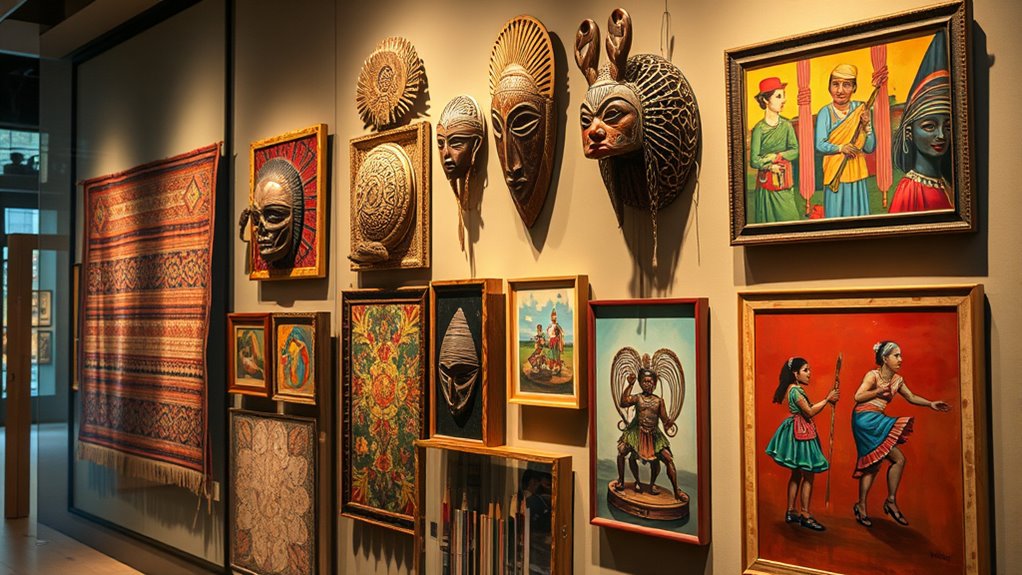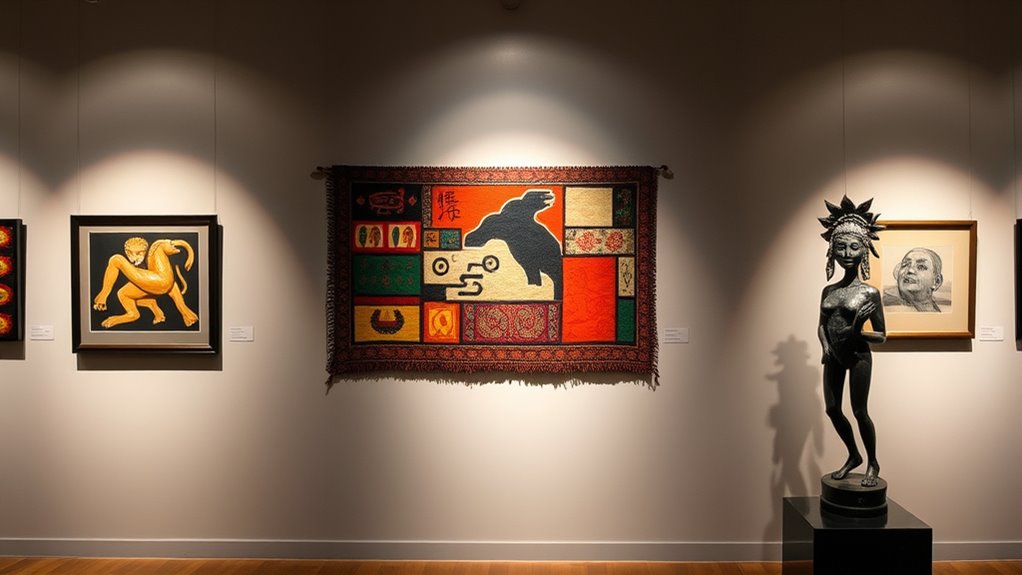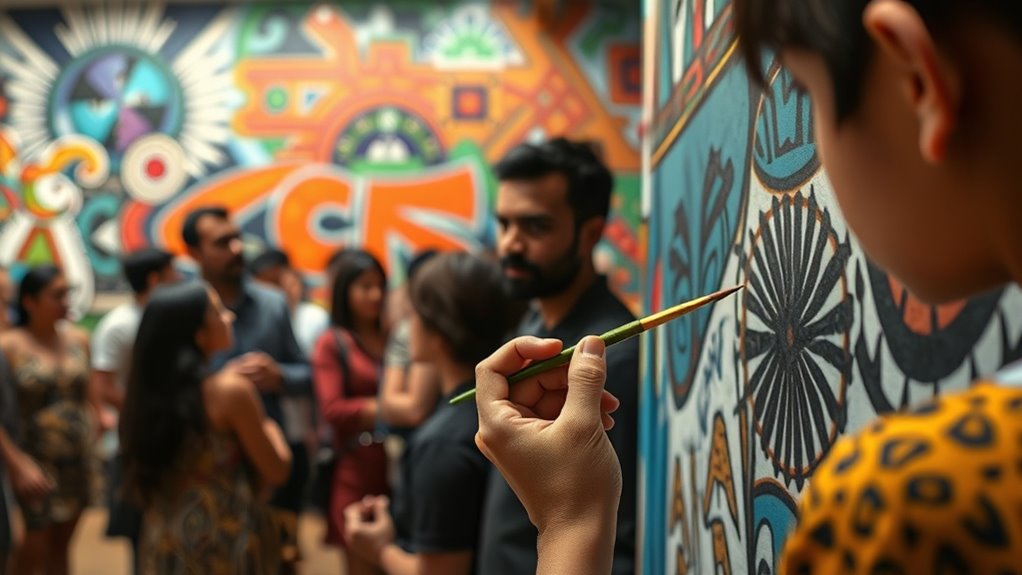Cultural appropriation in art sparks debates about whether you’re respecting a culture’s symbols or simply taking without permission. When you borrow motifs or practices without understanding their significance, it can be seen as stealing or disrespecting the originating community. Power imbalances and market interests often influence these choices, making it more complex. If you want to recognize when your actions are respectful or problematic, exploring these topics further will provide valuable insights.
Key Takeaways
- Cultural borrowing becomes problematic when it involves unpermitted use of symbols with deep cultural significance.
- Power imbalances favor dominant cultures that appropriate from marginalized groups, often leading to exploitation.
- Ethical artistic practice requires respectful engagement, acknowledgment, and collaboration with originating communities.
- Legal issues arise when cultural elements are used without permission, potentially infringing on intellectual property rights.
- The distinction between borrowing and stealing hinges on intent, context, respect, and the recognition of cultural value.
The Evolution of Cultural Borrowing in Artistic Practices

The evolution of cultural borrowing in artistic practices reveals how artists have continually reshaped their creative processes by integrating elements from various cultures and real-world objects. In the early 20th century, artists like Picasso and Braque used real objects, fueling the development of cubism. Dadaism, through Marcel Duchamp’s readymades, challenged traditional art by transforming everyday items into artworks. During the late 19th century, Japanese art influenced artists like Monet and Toulouse-Lautrec, introducing new styles and motifs. Cubist collages used newspaper clippings, prompting debates on representation. The Pop Art movement of the 1950s further embraced appropriation, utilizing existing images and objects to create new meanings. This ongoing history demonstrates how artists continuously borrow from diverse sources, reshaping artistic boundaries and questioning originality. Cultural exchange has been a fundamental aspect of this process, fostering innovation and dialogue across different societies and eras, while artistic innovation often stems from such cross-cultural influences. Additionally, the incorporation of traditional motifs from various cultures has played a crucial role in expanding the expressive vocabulary of contemporary art, highlighting the importance of cultural sensitivity in modern artistic practices. Recognizing the role of cultural appropriation helps to better understand the complex dynamics involved in the evolving landscape of art and cultural identity. Furthermore, the development of multicultural influences has enabled artists to explore new themes and perspectives, enriching the dialogue between tradition and modernity.
Differentiating Appreciation From Appropriation

As artists and audiences continue to explore cultural influences, distinguishing between appreciation and appropriation becomes increasingly important. Appreciation involves respectful engagement, understanding, and acknowledgment of another culture’s significance. It’s about seeking permission, learning its history, and collaborating with members of that culture when possible. The goal is to honor and celebrate, not exploit. Appropriation, on the other hand, often lacks consent and is motivated by personal or commercial gain. It can perpetuate stereotypes and cause offense, especially when cultural elements are misunderstood or misused. To differentiate, consider your intent, whether you’re seeking genuine understanding or simply borrowing for profit. Recognizing the historical context of cultural exchanges Respectful appreciation fosters connection and empowerment, while appropriation risks harm and misrepresentation. Understanding these differences helps promote ethical cultural engagement in art. For instance, cultural sensitivity plays a vital role in ensuring respectful interactions and avoiding harmful stereotypes. Additionally, understanding the 16PF traits can aid artists in reflecting on their own motivations and behaviors when engaging with other cultures, which aligns with the broader AI Ethics and Responsible Development principles of transparency and accountability in cultural exchanges. Furthermore, cultivating digital literacy is essential for navigating cultural influences responsibly in today’s interconnected world.
Power Dynamics and Ethical Considerations in Cultural Use

Power dynamics deeply influence how cultural elements are shared and used in art, often revealing underlying inequalities. When a dominant culture adopts symbols from marginalized groups, it benefits from privilege and influence, often without understanding their deep significance. This imbalance allows the dominant culture to profit and gain visibility, sometimes at the expense of the source community’s voice. Institutions frequently support this exchange but may neglect equitable representation or consent from marginalized artists. Cultural symbols are often commercialized, reinforcing stereotypes and perpetuating power imbalances. As an artist or viewer, you should recognize these dynamics and question whether cultural use respects the source community’s rights and history. Understanding the historical context of cultural symbols is crucial for ethical engagement. Ethical considerations demand that cultural exchange be reciprocal, respectful, and rooted in genuine understanding, not exploitation. Recognizing the role of cultural appropriation can help foster more respectful and equitable artistic practices. Additionally, awareness of content discoverability and how it influences trends can help consumers critically evaluate the origins and implications of popular cultural elements. Being mindful of the cultural content you engage with allows for more ethical and informed participation in artistic expression. Recognizing the importance of cultural significance ensures that cultural elements are used in ways that honor their origins and meaning. A deeper understanding of cultural heritage preservation can contribute to more responsible and respectful use of cultural symbols in art.
Case Studies: Controversies and Conversations in Art

Controversies surrounding cultural appropriation in art often spark intense debates about legality, ethics, and artistic freedom. These cases highlight the complex balance between protecting creators’ rights and fostering free expression. For instance, in Jeff Koons’s “String of Puppies,” a photographer sued for using his image. The court ruled against Koons, emphasizing commercial gain and minimal transformation as barriers to fair use. Nadia Plesner’s political artwork referencing Picasso’s Guernica faced a lawsuit from Louis Vuitton. The court favored artistic freedom, affirming the importance of political commentary over trademark claims. Rosalia’s embrace of flamenco culture drew criticism for cultural oversimplification, revealing power imbalances in global music scenes. These examples expose the ongoing tensions in defining acceptable cultural borrowing and demonstrate how cultural narratives are often at the heart of such disputes. Additionally, the debate often involves copyright law considerations, which are crucial in determining whether a work constitutes infringement or fair use. The evolving landscape of intellectual property rights continues to shape how artists navigate borrowing and originality. Furthermore, the influence of diverse cultural designs in art underscores the importance of respectful and contextual engagement with different traditions. Recognizing cultural sensitivity as a vital component can help foster more equitable and informed artistic exchanges.
Navigating Responsibility and Respect in Cultural Engagement

Engaging with other cultures through art requires more than just borrowing visuals or motifs; it demands a sincere effort to understand and respect their deeper meanings. You need to recognize the cultural significance behind symbols and motifs, avoiding superficial use that can offend or misrepresent. Be open to feedback from the originating culture and willing to make amends if your work causes harm. Respect and acknowledgment are key—credit the origins of your inspiration and understand the power dynamics involved. Aim for meaningful engagement, not exploitation, and consider collaboration when possible. Societal standards evolve, so stay informed about cultural sensitivities. Appropriation can involve using existing content without permission, and by doing so, you foster cross-cultural understanding and ensure your artistic expression honors the cultures you draw from, transforming appropriation into respectful cultural exchange. Understanding the Legalities and Zoning aspects related to cultural symbols can also help prevent unintentional misuse. Additionally, being aware of market dynamics can guide you in responsibly navigating the broader cultural landscape.
Frequently Asked Questions
How Do Legal Rights Influence Cultural Appropriation Debates in Art?
Legal rights shape cultural appropriation debates by defining what’s protected and what’s fair use. When works aren’t copyrighted, you can freely use them, but legal limits exist for copyrighted material. You need to contemplate court rulings like Warhol’s to understand fair use. These laws influence whether artists can borrow cultural elements without legal repercussions, but ethical concerns about respect and ownership also play a crucial role in these discussions.
Can Cultural Appropriation Ever Be Justified or Beneficial in Art?
You ask if cultural appropriation can be justified or beneficial in art. It can be, when done with respect, research, and meaningful engagement. If you transform and reinterpret sources thoughtfully, you’re fostering understanding and inclusion. Using cultural elements to empower marginalized groups or challenge stereotypes can promote positive change. However, you must avoid stereotypes, exploitation, or superficial use, ensuring your work respects and honors the source cultures.
What Role Do Museums and Galleries Play in Addressing Appropriation Issues?
Museums and galleries play a crucial role in addressing appropriation issues by promoting cultural sensitivity and ethical practices. You can support inclusive curation, involve cultural advisory boards, and collaborate with diverse artists to guarantee respectful representation. Engaging communities through outreach, educational programs, and digital platforms helps foster understanding. Developing policies and training staff on cultural awareness further ensures that institutions handle cultural elements responsibly and avoid perpetuating stereotypes or harm.
How Does Digital Media Impact Cultural Borrowing and Its Perceptions?
It’s no coincidence that digital media shapes how you see cultural borrowing today. You actively share and critique art across borders, often without realizing how quickly trends spread. Platforms like TikTok and Instagram amplify diverse expressions, but they also blur lines between appreciation and appropriation. You must stay aware of cultural sensitivities, engaging respectfully with cultures, and understanding that digital diffusion impacts perceptions—sometimes fueling misunderstandings or fostering genuine appreciation.
Are There International Differences in How Cultural Appropriation Is Viewed Ethically?
You’re curious if different countries see cultural appropriation differently ethically. You’ll find that perspectives vary widely: Western nations often focus on individual rights and economic effects, while the Global South emphasizes community rights and historical context. In some cultures, borrowing is seen as respectful, but commercialization without benefit is contentious. Recognizing these differences helps you understand that cultural norms shape what’s acceptable or offensive across diverse societies.
Conclusion
As you navigate the complex world of cultural borrowing, remember that respecting origins isn’t just a 21st-century trend—it’s been vital since the Renaissance. Approach art with the mindset of a conscious curator, balancing appreciation with ethical responsibility. Whether you’re inspired by a culture or borrowing elements, prioritize respect and understanding. In this digital age, where sharing is instant, it’s your responsibility to guarantee your creative choices honor the roots they come from, avoiding a modern-day “catastrophe.”









